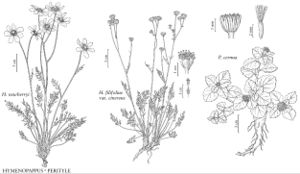Hymenopappus
Hymenopappus, plate. 1788.
| Taxon | Illustrator ⠉ | |
|---|---|---|
 | Hymenopappus newberryi Hymenopappus filifolius var. cinereus Perityle cernua | Marjorie C. Leggitt Marjorie C. Leggitt Bee F. Gunn |
Biennials or perennials, to 120 cm. Stems erect, often scapiform (1 stem per crown in biennials, usually 3+ in perennials). Leaves mostly basal or basal and cauline; alternate; petiolate; blades usually 1–2+ times pinnately lobed (lobes usually ± filiform), ultimate margins usually entire, rarely toothed, faces glabrous or hairy, often tomentose, usually glanddotted as well. Heads radiate or discoid, in ± corymbiform arrays. Involucres obconic to hemispheric, 4–15+ mm diam. Phyllaries 5–13+ in 2–3+ series, subequal, usually membranous or scarious-margined (often yellowish, whitish, or purplish). Receptacles flat or convex, epaleate (except H. newberryi). Ray-florets 0 or 8, pistillate, fertile; corollas white to ochroleucous. Disc-florets 12–70+, bisexual, fertile; corollas usually yellow to ochroleucous or whitish to purplish, tubes longer than or about equaling funnelform or abruptly dilated, campanulate throats, lobes 5 (reflexed at anthesis). Cypselae obpyramidal (4-angled, sometimes 5-angled, each face usually 1–4-ribbed, glabrous or hirtellous to villous); pappi 0 or of 12–22 orbiculate to spatulate scales. x = 17.
Distribution
North America, Mexico
Discussion
Species 11 (10 in the flora).
My treatment of Hymenopappus is essentially an adaptation of that by B. L. Turner (1956).
Selected References
Lower Taxa
Key
| 1 | Perennials (usually 3+ aerial stems from crown); cauline leaves mostly 0–12; heads 1–20(–50) per stem; disc corolla throat lengths 2–8 times lobes | > 2 |
| 1 | Biennials (usually 1 stem from crown); cauline leaves (2–)10–100; heads (15–)20–200 per stem; disc corolla throat lengths 1–2(–3) times lobes | > 5 |
| 2 | Ray florets 8 | > 3 |
| 2 | Ray florets 0 | > 4 |
| 3 | Basal leaves 12–25 cm; peduncles 6–15 cm; pappi 0, or 0.01–0.1 mm (receptacles paleate) | Hymenopappus newberryi |
| 3 | Basal leaves 8–14 cm; peduncles 3–8 cm; pappi 0.4–0.6 mm | Hymenopappus radiatus |
| 4 | Leaf blades simple or 1-pinnate; cypselae glabrous or sparsely hirtellous | Hymenopappus mexicanus |
| 4 | Leaf blades 2-pinnate; cypselae hirtellous to villous | Hymenopappus filifolius |
| 5 | Ray florets 8 | Hymenopappus biennis |
| 5 | Ray florets 0 | > 6 |
| 6 | Basal leaves simple or 1–2-pinnate, lobes (1–)5–30 mm wide; disc corollas whitish or purplish (not yellowish), tubes 2–3 mm | > 7 |
| 6 | Basal leaves 2-pinnate, lobes 0.5–6 mm wide; disc corollas whitish or yellowish, tubes 1.5–2.2 mm | > 8 |
| 7 | Basal leaves simple or 1-pinnate; disc corollas usually purplish, rarely whitish; pappi 0.3–2 mm | Hymenopappus artemisiifolius |
| 7 | Basal leaves 1–2-pinnate; disc corollas whitish; pappi 0.1–1 mm | Hymenopappus scabiosaeus |
| 8 | Lobes of basal leaves 1–6 mm wide; disc corollas yellowish; pappi 0.5–1.5 mm | Hymenopappus flavescens |
| 8 | Lobes of basal leaves 0.5–1.5 mm wide; disc corollas whitish; pappi 1–1.5(–2) mm | > 9 |
| 9 | Disc corollas 3–4 mm, throats ± funnelform | Hymenopappus carrizoanus |
| 9 | Disc corollas 2.5–3 mm, throats ± campanulate | Hymenopappus tenuifolius |